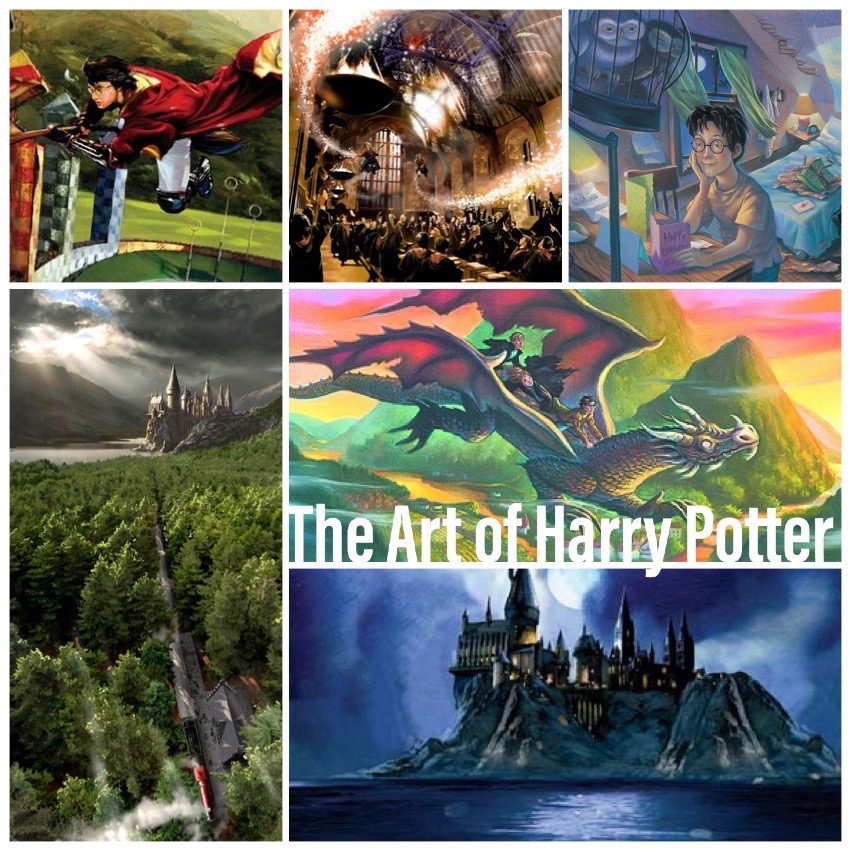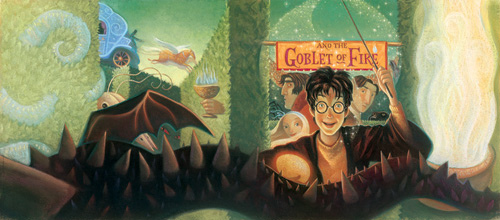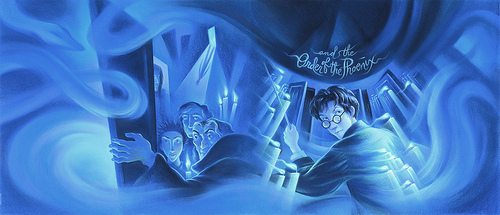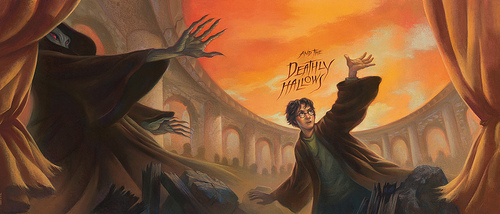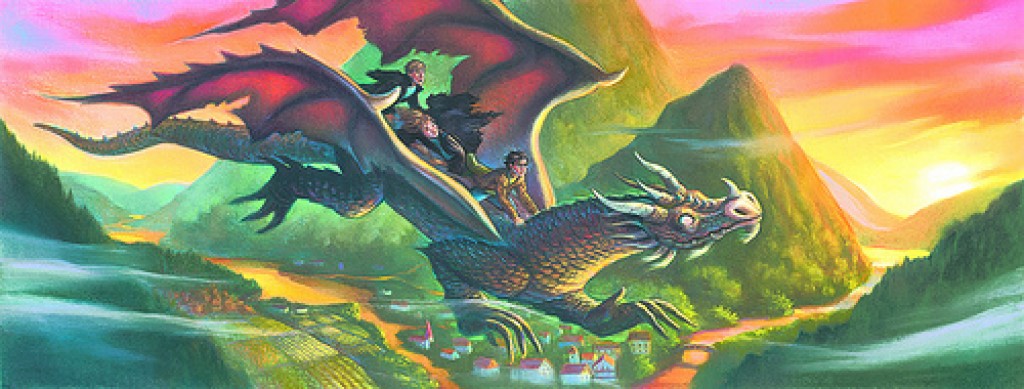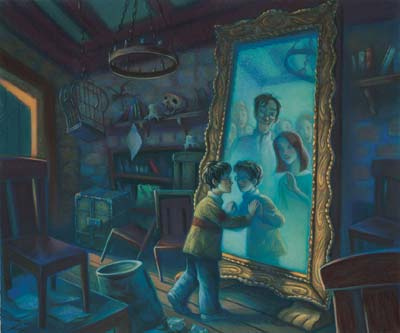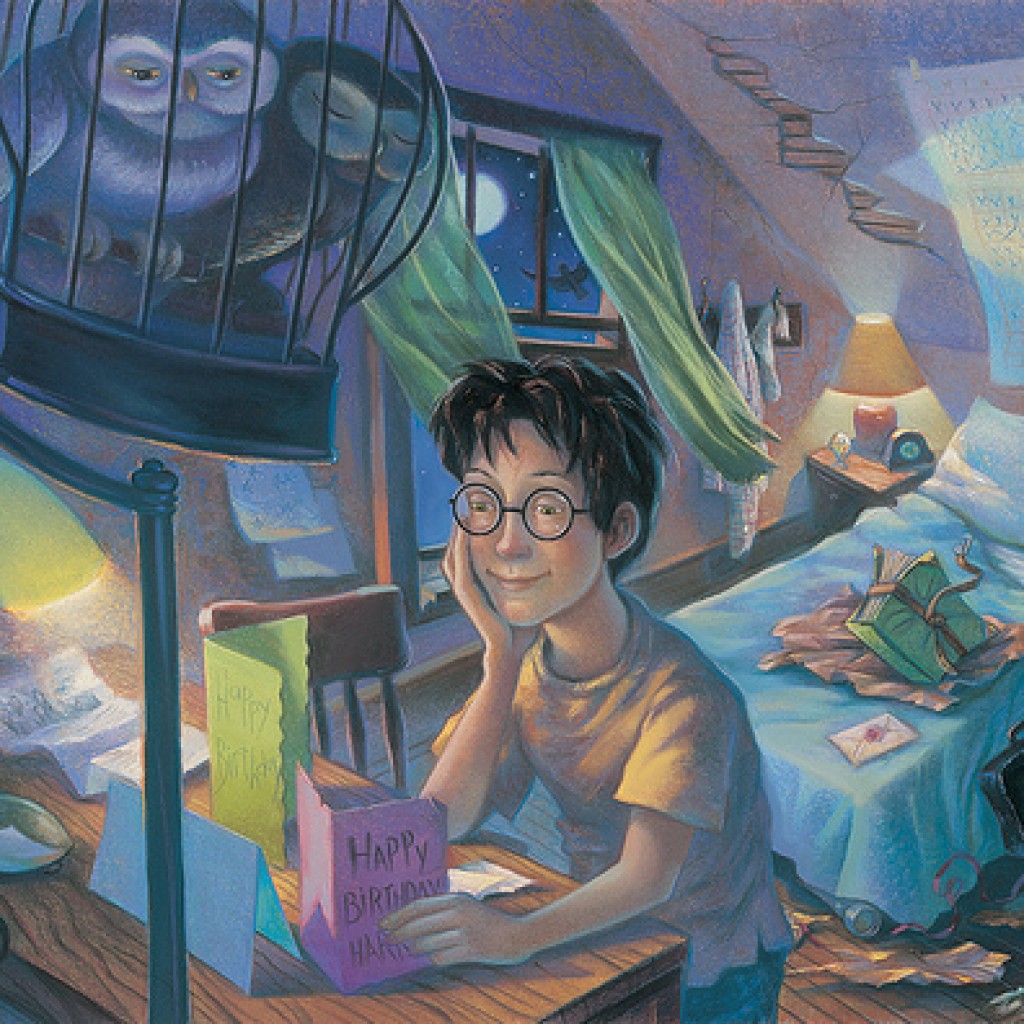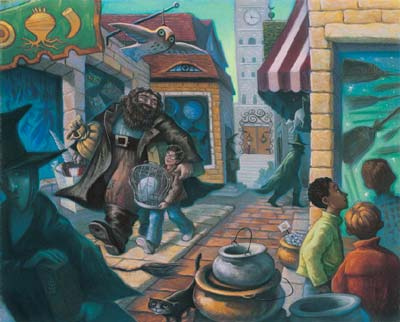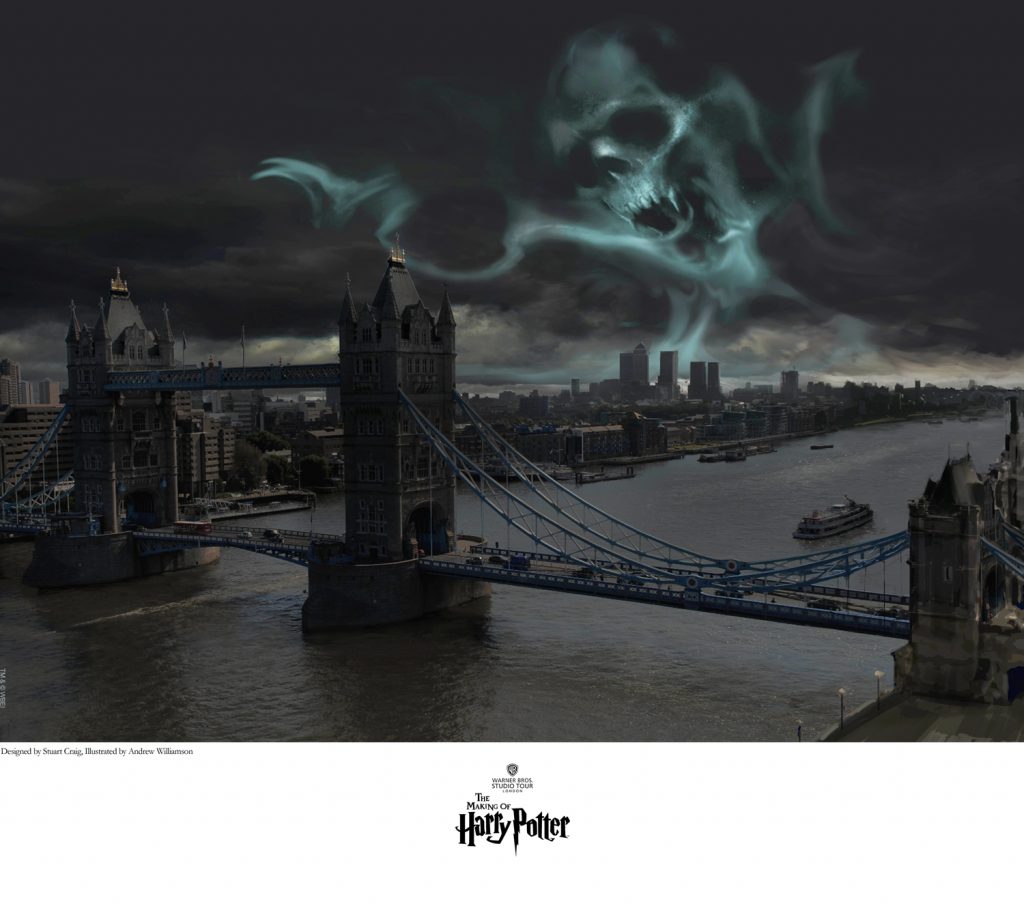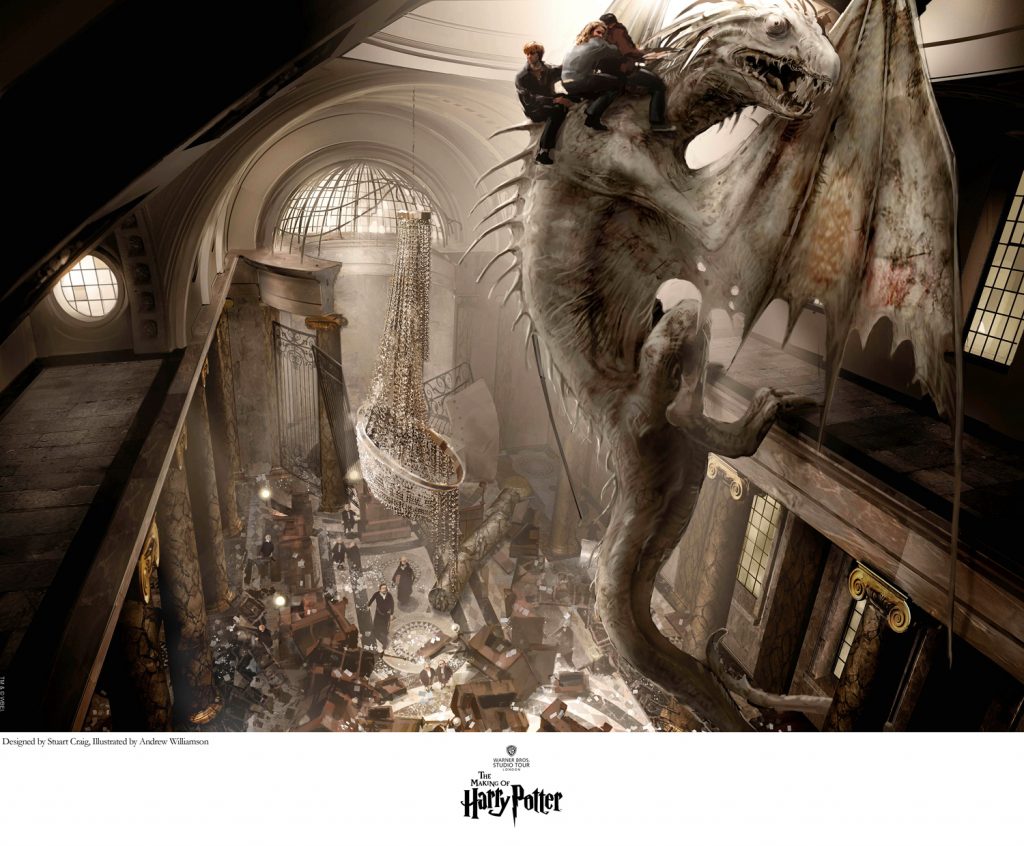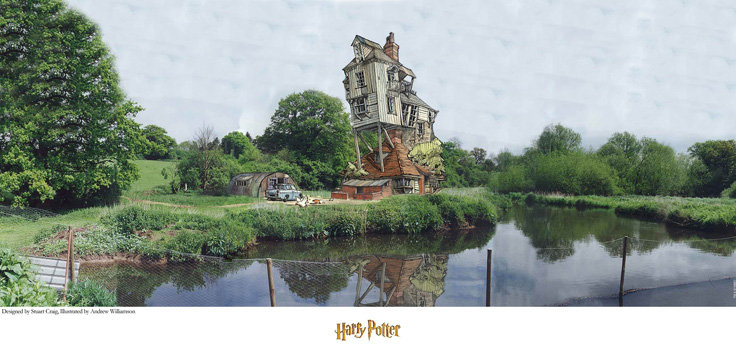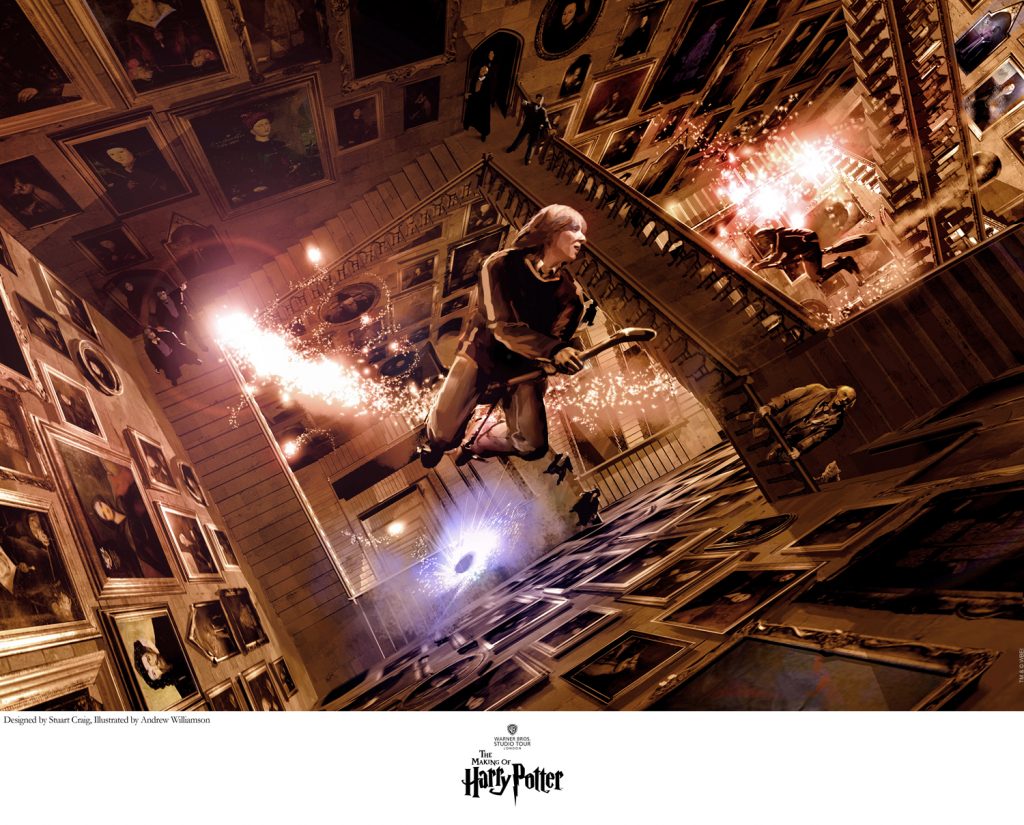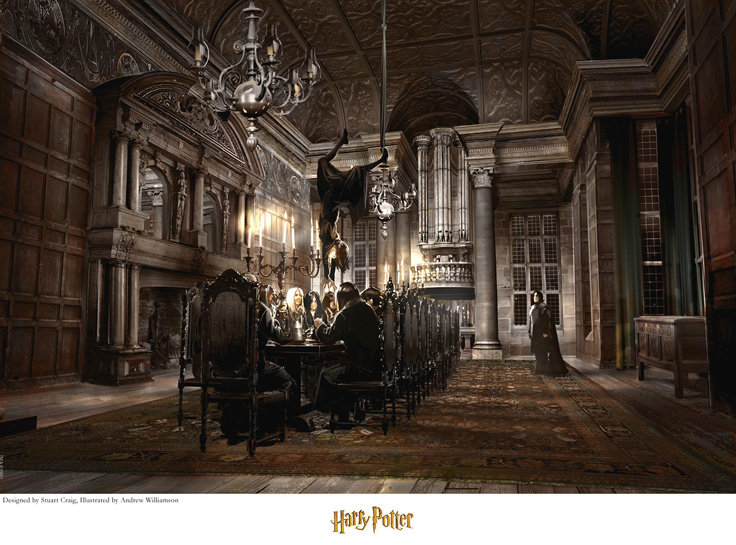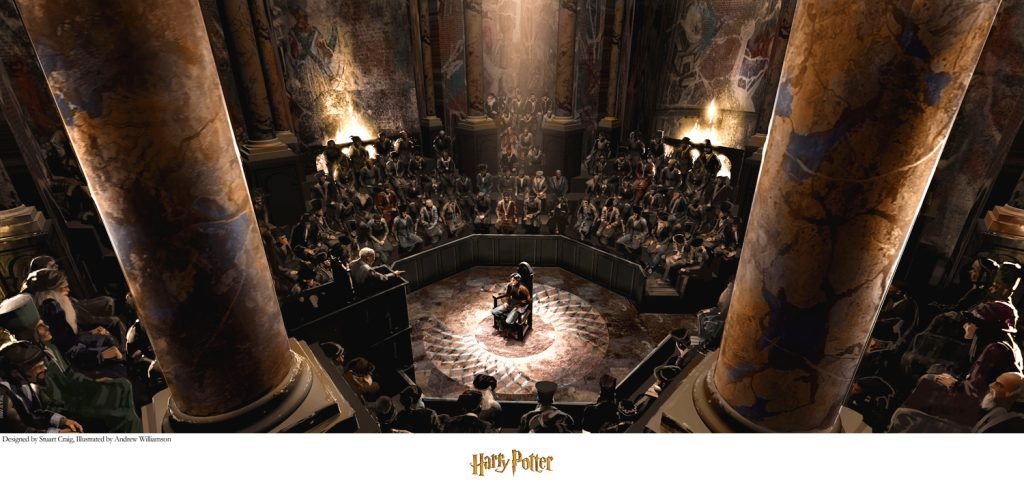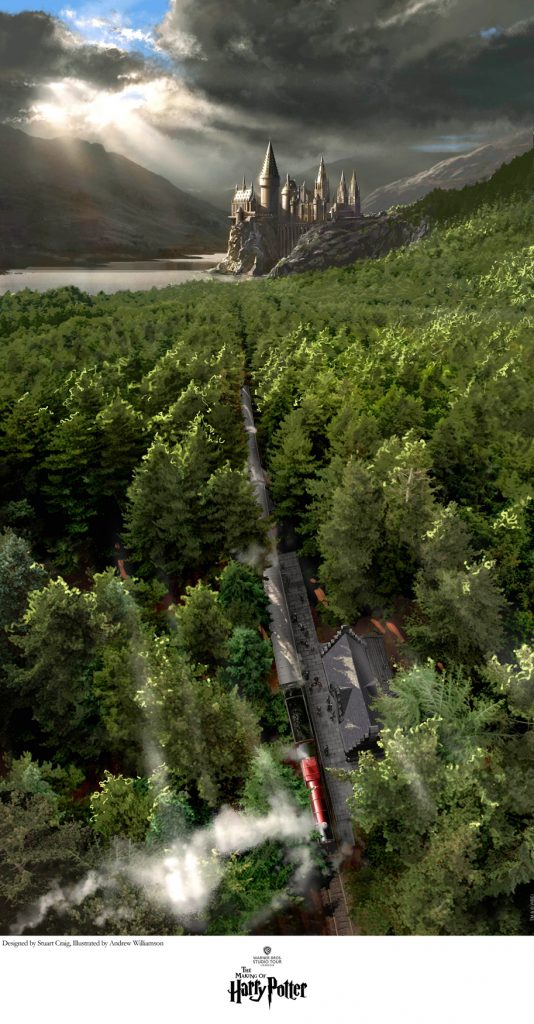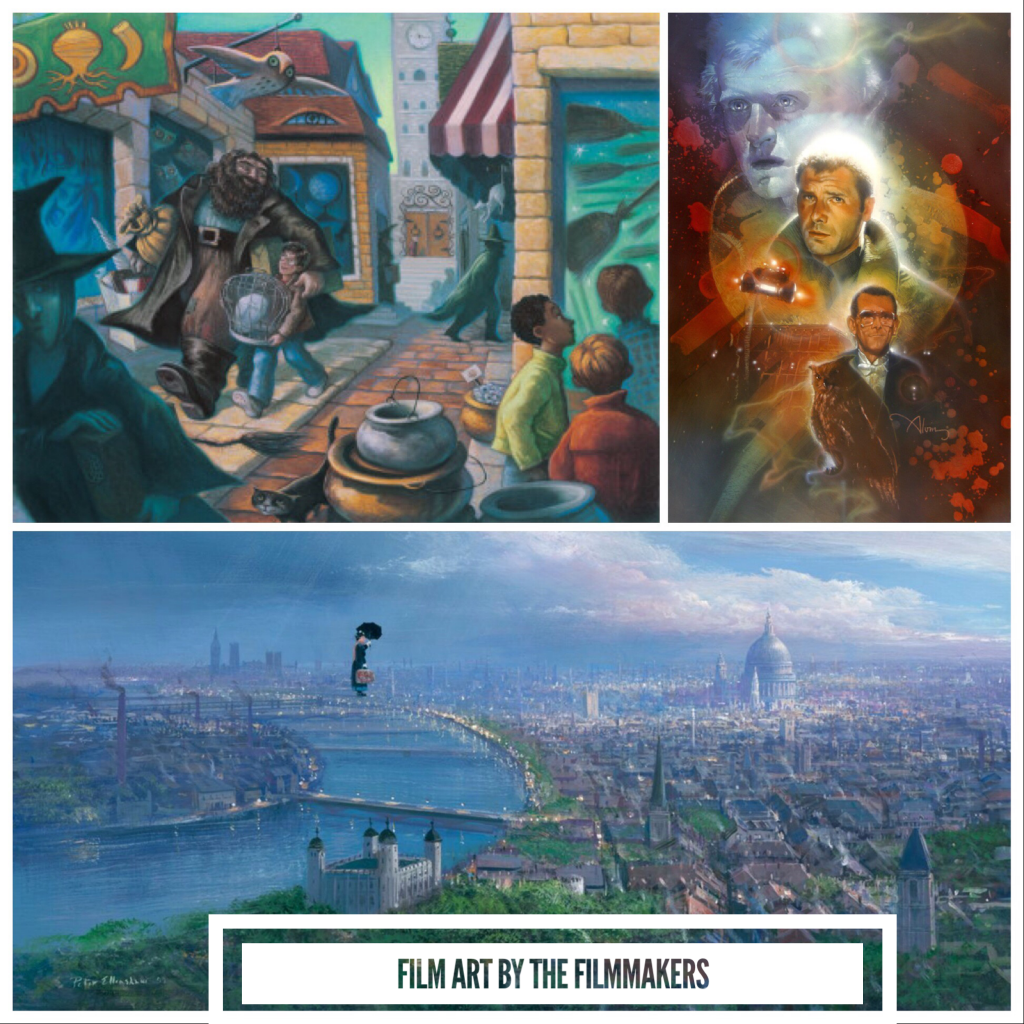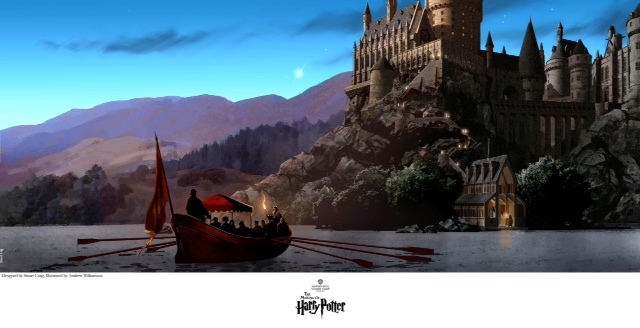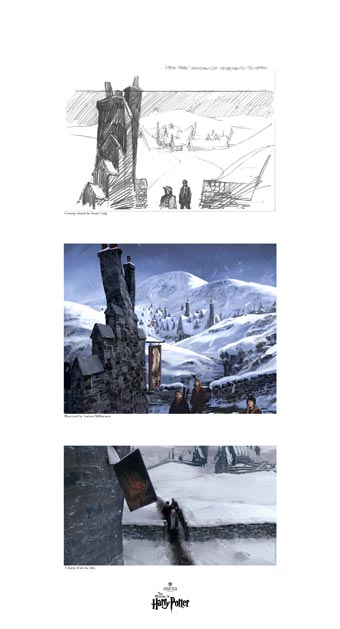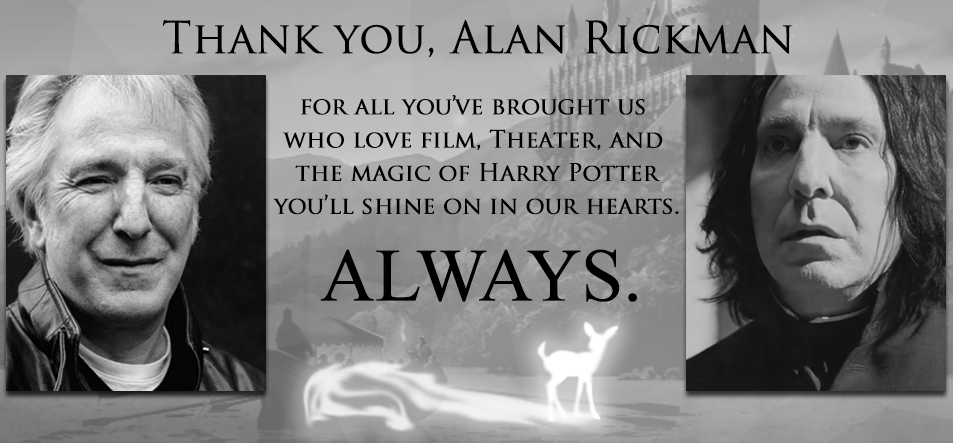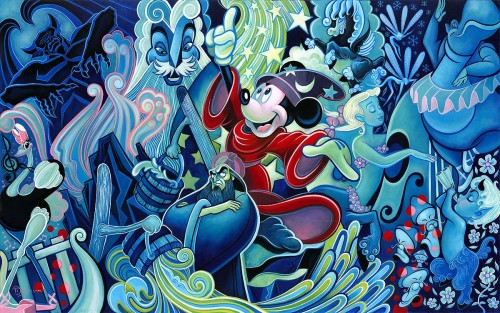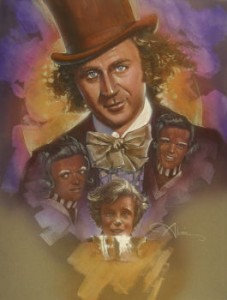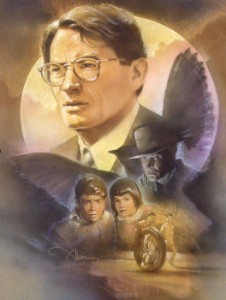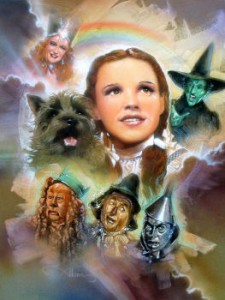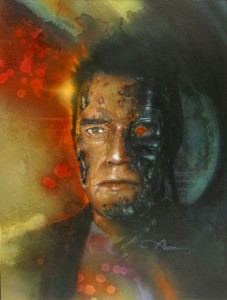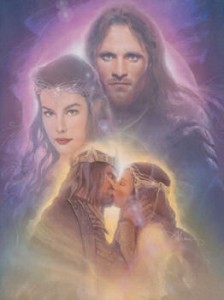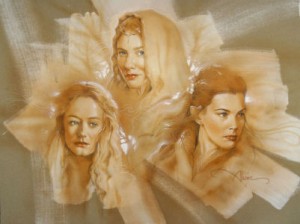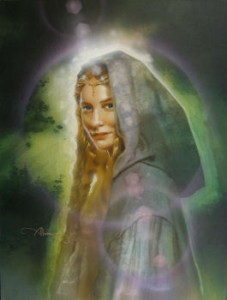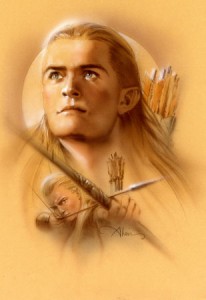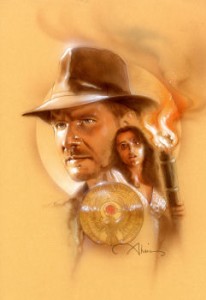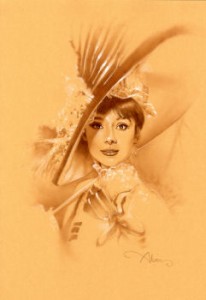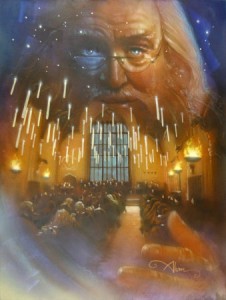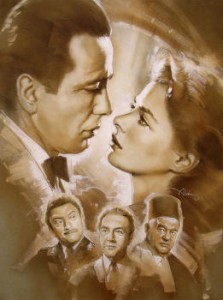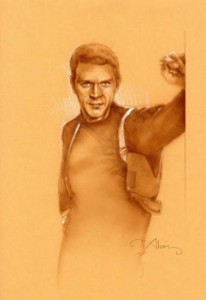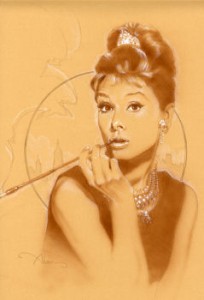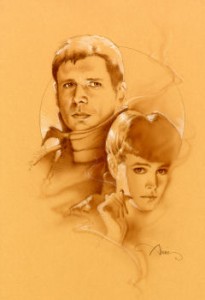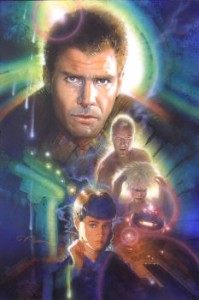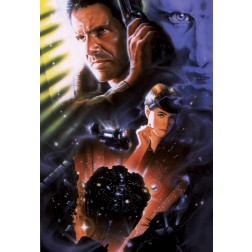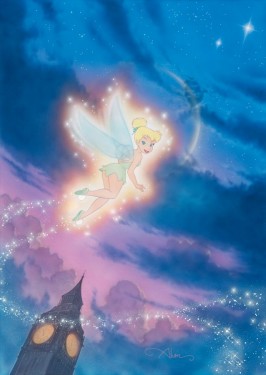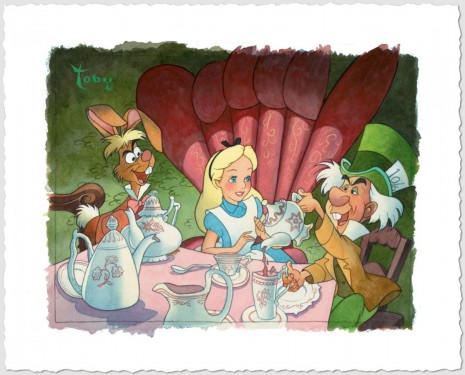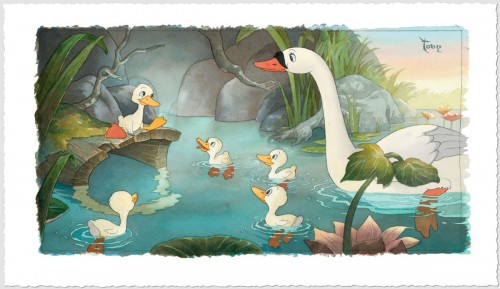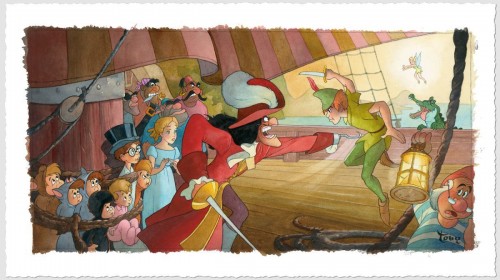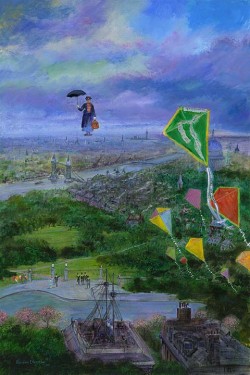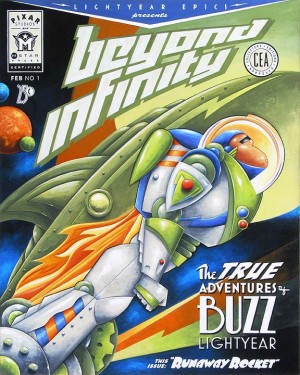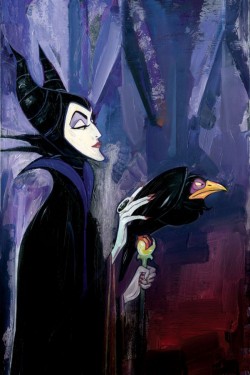In the just-released HBO Max releasing Harry Potter 20th Anniversary: A Return to Hogwarts, Harry Potter film franchise production designer Stuart Craig is mentioned and called up fondly by a number of cast members. For good reason! Apart from the cast, Stuart Craig, who worked on the entire series, is one of the players that kept the continuity and look of the films consistent from beginning to end. A 3-time Oscar winner for Gandhi, Dangerous Liaisons, and The English Patient, Craig has been in the film business since he started in 1967 on Casino Royale as an assistant, bringing tea, running errands, and studiously avoiding Peter Sellers. Needless to say, I’ve loved having Stuart Craig Harry Potter art in the gallery.
He was hired from the very beginning of the Harry Potter series, designing the look of Hogwarts and the extended world of the boy who lived, interpreting and bringing to life the spaces and environments as written by JK Rowling.
Now here we are, 20 years after the first film’s release, and Warner Brothers celebrated by releasing a new documentary featuring all the major players from the film (though sadly missing Alan Rickman, Richard Griffiths, and Richard Harris, and Helen McCrory, among other cast and crew no longer with us). Neither Stuart nor any other below-the-line artist was interviewed, but that doesn’t diminish the importance of their contributions to these magical movies.
One of the subjects around the reunion that created controversy was whether it would include Rowling herself. In recent years she has, to put it mildly, put repeatedly her foot in her mouth on social media by clearly being trans-exclusionary. You can read all about it HERE. Ultimately, they used about 2 minutes (out of 2 hours) of footage from 2019. This brings us to why my post is titled “last available Harry Potter art”.
Since the books were released, I’ve been a champion of Harry Potter art. I’ve even been a panelist on several Harry Potter fandom panels at San Diego Comic-Con! (Here’s one video of us talking HP from 10 years ago, and yes, that IS a pre-Glee, shaggy-haired Darren Criss sitting next to me!)
I have definitely sold more Mary GrandPre and Harry Potter concept art than anyone else. I even got to release two exclusive limited editions. Regardless of how much of a fan of the art, the books, and the movies I might be, when Rowling started her row with the world about what is and isn’t male and female, and why, I had to reconsider my stock, and think about whether I wanted to put another penny into her pockets. The answer was no. At the time, I was well-stocked with official limited edition art from Harry Potter, both the books and the movies. Though until now I’ve done it below the radar, I slowly sold off what was available through ArtInsights, and vowed to myself I would stop selling the art when all the Harry Potter art in my current inventory was gone.
Should one of the artists I know who worked on the films and has original art comes to me, I’ll still be willing and able to promote and find great homes for their art, but the days of supporting the limited edition market are over, but for the last remaining pieces I have, which are all pieces I’d put aside by Stuart Craig, many of which are Artists Proofs.
So: If you’re interested in the movies, and love the characters and the movies as much as I do, check out all the Stuart Craig Harry Potter art HERE.
A large part of why I fell in love with the Harry Potter movies was the look and feel of them, and that’s entirely to the credit of Stuart Craig.
I interviewed Stuart in 2011, before the release of the last Harry Potter movie. I spoke to him about how he got started, artist’s block, his inspirations, and advice for aspiring production designers, among other things. You can listen to it on the video below, or scroll down to read the transcript.
Stuart Craig interview transcript
Leslie Combemale:
So, how did you get started? What led you to becoming a production designer? Did you love movies as a child?
Stuart Craig:
It wasn’t movies, specifically. When I was in school in my hometown, there was a tradition of doing musical operettas, Gilbert and Sullivan particularly. I wasn’t a great academic student and I was always, you know, hanging around the art room. My mother discovered quite late on in her life that she had a talent for painting. She was 65. Anyway, there was a Gilbert Sullivan thing, and I was painting scenery, painting the stone wall of the Tower of London, and somebody behind me admired it, and, I was totally surprised, really, that I created any interest at all from anybody else, and that was a little trigger. Later on in my school life, I did some amateur theater work painting scenery for two complimentary tickets a week. There were two theaters in my hometown, and I work in both of them. At the same time, I pursued my art, went to the local art school, then went to a London art school, and did work in London theater. My day work was as a student at London art school. As art school students do here, at the end of my course, I looked for a kind of postgraduate course, and the Royal College here in London had a course in film design. I thought, ‘well, I can maximize my chances of getting in here just using my theater experience.’ So that was it. I was being pragmatic, really, in going to film school thought that is the way to develop the experience I have possibly, even a way to have a slightly better paid career, so that’s what I did, and it was film forevermore after that, really. When I left the Royal College, I got a job on the first Casino Royale film, the one with everybody in it. Peter Sellers, David Niven, Woody Allen, I don’t know if you’ve ever heard of it.
LC:
I think I’ve seen almost everything you’ve ever done, with the exception of Saturn City that I have not seen.
SC:
As a quick introductory course to film technique, it was pretty good. I have to say it couldn’t be better, in fact.
LC:
You were doing art direction for that?
SC:
No, I was very, very junior. I made the blueprints and made the tea. There’s very much a tradition of that in the movie industry, that you start in one of these junior positions, and serve an apprenticeship, and then you kind of work your way up.
LC:
Making tea for Peter Sellers, that’s kind of entertaining though.
SC:
I didn’t dare go anywhere near Peter Sellers. I was making the tea for the art directors and the guys in the art department.
LC:
So then from there, you got involved in terms of working with Richard Attenborough?
SC:
Yeah. Well, I served in quite a lot of apprenticeships, for about 12 years. From that tea boy to draftsman to art director was about a 12 year process. I worked for RIchard Attenborough actually on Gandhi in that period, but it was one of those false starts that he had. I mean, he tried to make that movie for 20 years. We set up an art department, and did some work. I was working for another designer called Michael Stringer at that stage. It fell through, it didn’t happen, so I went on, did other things, and then eventually, 12 years later got to design the first film of my own. I think either the second or third film I did was Ghandi, which was huge for one so green and comparetively new as a designer, That was a big challenge.
LC:
When you got the job of doing Gandhi, did you feel like you had built up enough knowledge and experience that you felt like you were ready for it? Or did it feel just enormous at the time?
SC:
Over my 12 year apprenticeship, I did begin, towards the end, to think ‘I can do this’, so was ready for it in that sense. I was also smart enough to choose two very, very good art directors to go with me, both of whom were older than I, and had more experience than I had. Looking back on it it was a pretty smart move.
LC:
What’s your take on the way you use color? Because for instance, in The Elephant Man, I see a lot of shadow and light, and almost using your gray tones as color. But then you also do definitely use color almost as a character in your movies.
SC:
I think that’s true. I think there’s a tradition here in England, maybe here more than in America, or certainly more than in California, of kind of limiting the palette. Maybe it’s because we live in a gray, rainy place. You know, our sensibility is just different. But with Stephanie McMillan, the decorator, I consult all the time on matters of color. We do have this technique of limiting the palette, very, very severely, so that the subtlest of color changes register quite strongly. I also do love, obviously, to have built sets with potential for dark shadows, and consider initially each set as something abstract, and as a piece of sculpture, literally, pieces of abstract sculpture, with a lot of thought given to how it might be lit. Now obviously, it’s a communal activity, and I need to talk to the director of photography about that. So I have tried, as well as consulting with the director right off, then the cinematographer as soon as they are available, becomes an essential part of the plan.
LC:
You start out with a limited palette and then you add color based on what calls for it and where it makes sense?
SC:
Well, certainly in Hogwarts, almost every color is muted, or has a lot of gray. So we work in sort of gray greens, gray ochre, and it’s limited in that way. Occasionally, you might go for sharp color, or go for reflective color. In the Harry Potter films, we’ve used a lot of gold leaf, or actually brass leaf, because gold is fairly expensive. We’ve used brass leaf but it gives it a kick, and it has a quality that gold spray paint could never have.
LC:
So even if you pull out all the color, you’re still going to get a slap of color by using the brass?
SC:
Yes. But it’s more for its reflective qualities than for yellow gold color. Well, I guess it’s a combination of both.
LC:
So it’s playing with light as well as color.
SC:
Yes, exactly.
LC:
When you’re doing all of these projects, you’ve got the the producer and the director, and then in the case of Harry Potter, you’ve got the author, how does the involvement work? Who gets called in first? And how do you figure out the process and the collaboration with all those people together?
SC:
There was a promise made by David Heyman, the producer, to JK Rowling, that we would be faithful to the spirit of the books, but she understood that we could never include everything. There had to be huge omissions. And I think she was very brave in allowing the films to be their own separate entity. She quite accepted from the beginning that books and movies could be separate, and so we consulted her initially. She literally gave me a map of Hogwarts, a map of the world. She did the drawing over the first meeting in a hotel lobby, and that became a massive aid or a starting point from her. We consulted her throughout the series when there were questions. As to the director/producer relationship, the designer would always address the director first, and have an initial conversation to understand his priorities, and then I would prepare a sketch or model in the art department, and go back to him and show it, and then at that stage, maybe introduce the producers to the idea, so that they were up to speed on what was happening. But it’s really that dialogue between the director and the designer, which is essential and you follow that path wherever it leads.
LC:
This is after the script has been written, and you’re reading over the script. Do you go back, whether it’s Harry Potter or some of the other movies you’ve worked on that are based on books as well, or novels, do you read the novels over and over so that you get a sense of some of the elements in the novels, or do you try to stick strictly to the script that’s written in the screenplay?
SC:
I think the background information is important as well. Quite early on the Harry Potter books were issued as spoken books on CDs, so that helped. I would read the novel, and then listen to it in the car on the way to the studio several times.
LC:
Stephen Fry’s version of Harry Potter?
SC:
Yes! It’s essential, and not just that and reading the novels, but then there’s a researcher, Celia Barnett, who worked with us on all the films, and I find that process important too. She was researching things like medieval clock mechanisms, because in the Prisoner of Azkaban this clock is important. She would research medieval architecture, and the tapestries in the common room. Celia found the tapestry for the Gryffindor common room, those bright red tapestries, from a museum in Cluny, in Paris.
LC:
In terms of the Harry Potter movies, has there been something where you’ve done everything and it’s been filmed, and then you look at it and you realize it just doesn’t quite have what you’re after, and you have to go back and change something?
SC:
One big thing. In the beginning, the Sorcerer’s Stone or the Philosopher’s Stone, we were obliged to use existing locations quite a lot, because we didn’t have the time or the money to build the entire world. When we then cut to a big exterior of Hogwarts, those are real places, like Gloucester Cathedral, Durham Cathedral, and Christ Church College at Oxford, all had to be incorporated into the complex which was Hogwarts School. This gave, I must say, a not a very satisfying silhouette, and I was at pains in subsequent movies. Fortunately, the script made different demands anyway, and required different geography. You know, if we had had all seven books from the beginning, then certainly those early decisions would not have been made or those early choices of location, because they didn’t fit with the action in later books. But anyway, we didn’t have that. So we used bits of cathedrals, and bits of Christ Church college. Then, when obliged to make those changes in subsequent movies, I did use take that opportunity to improve the silhouette of Hogwarts, just to make it more magical. It was confused. Although it was always huge and complicated, it did progressively get more elegant. Nobody seemed to mind, they seem to expect that it was just part of a magical world.
LC:
I would imagine, though, not having all of the books at once was a source of excitement for you, since you have worked on all of them.
SC:
Absolutely
LC:
What would you say in the last book were a couple of the elements that you were really excited about getting an opportunity to express visually?
SC:
Absolutely. I mean, the ministry suddenly appeared, and that was a huge challenge. Every book produced something new. In the last book, the seventh book, which we split, as you know, into two two movies, the challenge of the first part is that we don’t go to Hogwarts at all. The entire film takes place with the kids on the run from Voldemort. The ministry has turned bad, and they’re hunted, and on the run, so it’s a series of locations, physical locations, and sometimes built sets. There’s a frozen forest with a frozen pool, and the sort of gryffindor at the bottom of the frozen lake. That’s a set on a soundstage here in London, which has to be integrated with a bit of real forest that proceeds it. So, that was a challenge there. Something we were quite unfamiliar with really was traveling to distant locations for landscapes. Specifically. In part two, the great challenge is the destruction of Hogwarts. And you don’t just knock holes in what you’ve got, you really have to consider that as a new set. And again, this all important idea of strong profiles making strong images.
LC:
and all that fire, and the light coming through, and all these big sections of the castle that are knocked down.
SC:
The sun rising behind the smoke, all those considerations. But as I say, the big big challenge was these massive remains of destroyed walls, the entrance hall, the front of the Great Hall, part of the roof of the Great Hall, completely gone. So, yeah, a big challenge, and an enjoyable one, too, really. Maybe it helped help me and the guys in the other departments prepare for the end. We we demolished it before we had to strike it completely.
LC:
That might have been good catharsis. When I think about the two last movies, I was trying to imagine what would be really fun to design. The Lovegood house, and the wedding, and then at the beginning at the manor with the body hanging.
SC:
I think you’re right. Malfoy Manor is a very strong architectural set. The exterior is based on an Elizabethan house here In this country called Hardwick Hall, and it has massive windows and these windows are kind of blinded out, the shadows are drawn, and so they’re like blind windows, which have a real kind of ominous presence. So that gave us the basis of a good exterior. There’s an extraordinary magical roof added and surrounded by forest, which isn’t there in reality, but again, this is one of our devices to make it more threatening, more mysterious. Tthen the interior, two floors, two sets on stages, very, very muscular architecture, very strong architectural form. So that was great to get into that. The Lovegood house is a tower. JK Rowling says it’s a black tower in an empty landscape. That’s exactly what it is. But we took great care over the sculptural shape of that tower.
LC:
The interior is fantastic.
SC:
Luna and her father certainly both have eccentric interests. We asked Luna, Evanna the actress who played her, to actually help us with this, that she would have painted or decorated the interior with, like decorations on the wall murals.
LC:
Evanna painted for you?
SC:
She proved herself very good at this in Harry Potter six, where she wore the lions mask, or the lion headdress. She designed that, and so we thought, ‘ha! we’ll harness this ability again, this talent again, and ask her to do these wall paintings, and so she did designs for them which we then reproduced.
LC:
And Xenophilius Lovegood is new to that movie, right? So it’s exciting to be able to create the world of a new character.
SC:
Exactly. And he prints with his printing press, and one floor of this black tower is entirely consumed with his printing operation for The Quibbler, the magical world magazine. The press was good, and all that printing apparatus was great fun for Stephanie, the set decorator.
LC:
Did you make all of the furniture in curves?
SC:
Not exactly. There is a sort of spiral staircase, and some sort of fitted bits are made to fit the curved walls, but it’s it’s eccentricly furnished.
LC:
One really interesting aspect of the film is juxtaposing the wedding against the beginning of the movie, with its sharp contrasts and the dark and the shadows. There’s this little joyful moment in the book that takes place at the wedding, which is beautiful, and there’s a lot of light. And so how did you work that contrast?
SC:
We decided with the wedding that the wedding reception, as they often are, should be in a tent or a marquee, and that marquee should sit in this flat, marshy, weedy landscape outside the Weasley house. The big question was, do I make it the same, an extension of the Weasley house with the same kind of eccentricity, the same kind of rather amateurish, homemade feeling about everything, or do we do something different? Well, obviously the fun thing is doing something different. Since Bill Weasley was marrying Fleur Delacourt, we could say that her parents had a big influence on this wedding. In fact, that Monsieur Delacourt would probably pay for it as the father of the bride. That permitted us a French influence, and so we really went for that. There’s a soft, very refined interior, painted silk the tent is lined with, there are floating candles in little French 18th century candelabra, and so the whole thing has a very elegant and quite un-Weasly look about it.
LC:
How much would you say of your own artistic aesthetic gets put into the work that you do, specifically Harry Potter, because that’s what we’re talking about right now, but also on the whole?
SC:
I think in different categories, there’s probably a different answer. Everything architectural, I have a great deal of, not just control of, but it is what I’m passionate about, and reflects my interests and input. Along with Stephanie McMillan, the set decorator that we’ve already mentioned, we’ve worked together as a team for a long time now, since Richard Attenborough’s Chaplin, I think was the first time. So there’s already understanding that of the architectural part and the decoration of that thereafter. There are a team of concept artists working in the art department with me. Two and three of them sometimes were concerned exclusively with creatures, a lot of magical creatures in Harry Potter, like Thestrals and Hippogriffs. so, these guys, Rob Bliss, they have a fantastic facility for designing anatomically correct and credible, but extraordinary magical creatures. In the case of creatures, I am the facilitator, you know, as you say, the head of the department that in which they work, but it’s their creative input that that gets us there. They draw absolutely spectacularly well, you know, they draw like Raphael like Leonardo, they do. So, beautiful drawing. There’s another illustrator who is Andrew Williamson, an architecteral illustrator. I will do a rough doodle of a set the Lovegood House or the Malfoy Manor, and we’ll also do a plan and an elevation, quite a rough preliminary one, but nonetheless to scale, because I love to think I imagine it from with dealing with real dimensions right from the beginning, knowing exactly how big it is and exactly the size of one thing against another. And I give those early pencil sketches and plan and elevation to Andrew, he will then build a digital model in the computer and together we will spin it, walk through it, choose an angle, and say ‘okay, that it’, and render or illustrate that. Over the 10 year period, he started with pencil drawings and watercolor washes, but you know, technology has changed so fast. He does these amazing renderings which become so well finished that you can barely tell them apart from from stills directly from the movie. You can mistake some of these concept sketches for shots from the movie.
LC:
Does he still create analog art after you’ve gone through and seen all of these digital images? Or is it pretty much all inside the computer?
SC:
It’s all inside a computer now.
LC:
When did that switch completely?
SC:
It didn’t switch suddenly. In the beginning, he would take my things and then apply a pencil drawing to watercolor paper and put watercolor washes on it. Then, having gotten a computer, there was a period in the middle, where he would make the drawing on the computer, print it out onto watercolor paper and still do the sort of the washes. and then took the big leap and then the whole thing was on the computer. Also, I think, what Andrew took from us, and from the movie tradition of art director sketches, designer sketches, the idea of lighting, he came from architectural practice, helped architects do these overviews of architectural schemes, but the lighting in those traditionally is fairly bland, whereas lighting on movie sets is often dramatic and spectacular. And you see, from the first film to the last film, the lighting in these concept sketches has changed enormously, and has gotten much stronger and better and more exciting.
LC:
Do you as a film goer or somebody who appreciates movies, are there some in particular that you go back to just in terms of being a fan and using them as inspiration?
SC:
I have design heroes like Ferdinando Scarfiotti, he worked for Bertolucci. I think Scarfiotti was certainly the best designer of my generation. He died tragically young and didn’t get to do so much, but that Italian classicism that he was born with, and it was in his blood. He just had such a facility for doing things beautifully and elegantly.
LC:
Is there a particular movie that you love the most of his?
SC:
The Sheltering Sky is beautiful, and The last emperor. There’s a quirky movie called Toys, which he did to Barry Levinson, which wasn’t a successful movie, but it was very beautifully designed.
LC:
That’s a little bit like the beginning of the series with Harry Potter underneath the stairs. Those shots are really tight.
SC:
There’s a great American designer Dean Tavoularis, who worked for Francis Ford Coppola. Tavoularis has as a kind of great classical way of doing things and has a great eye and he’s all about making pictures, making sculptures, and he’s another hero of mine. There’s a movie about Las Vegas, that Coppola did. He took over a studio in Hollywood called Zoetrope, and I was working in a building, in an empty shop, next to Zoetrope, preparing for a film with Mel Brooks, and Tavoularis was working, and I remember walking onto one of their stages one day, and just seeing that he was using the most theatrical techniques, I mean, painted ground rows, painted backing, forced perspective, all these things which I tried to do in my work, but he is certainly a master of that. I remember that and taking encouragement from that. Okay, if you can do, perhaps I can do that.
LC:
I was just going ask you about that Kings Cross Station scene at the end of the movie. Did you have to think about that for a while? Sometimes when you’re creating a scene or a part of the movie, do you have to sit on it for a while and think about it?
SC:
Absolutely that. I think flashes of inspiration for me are quite hard to come by. I often sit in front of a blank sheet of paper and struggle and struggle and use the eraser a lot, but eventually something will form. Something like that is a very difficult concept. I mean, you’re talking about the thing with Harry between life and death?
LC:
At least in the book, there’s not a lot of direction in terms of how this scene is meant to look.
SC:
It was quite a protracted process, really. But we did experiment. W had the sense of it e being very burnt out. We experimented with underlit floors, and with different kinds of white coverings, white paint, and white fabric. The cameraman was involved. We needed to figure out how much to over expose it, so a series of camera tests were done. So we got there, but with a great deal of preparation and research.
LC:
Did it take way longer than any other scene to work out?
SC:
Given that the end result was really a very simple set, a very simple white platform surrounded by whiteboards, and there’ll be some visual effects enhancement there, the architecture will be put in, but there was there was a sketch that Andrew and I prepared, which became the kind of template, and after that, all these materials were experimented with.
LC:
And you just were touching on a little bit, but do you get a form of artists block?
SC:
Is it hard to take yourself to the drawing table and sit in front of a white sheet of paper. It’s really hard to do that. But what I’ve learned over the years is, once I do it, something will come. It will, and it always has, and I pray that he always well. You can get an idea in your head, and just the act of making marks, and then the marks become very simple forms, and the simple forms become architecture. And then the architecture has a texture, has an antiquity, is lined with book,s or is lined with paintings. The initial one or two stages are the important ones that get you going, and then the thing starts to flow faster.
LC:
Do you recall any particular flash of inspiration?
SC:
I think Picasso, and there was a famous Hollywood designer John DeCuir, certain very, very lucky people can see an image in their head complete, fully formed, fully rendered fully colored. And all they have to do is just reproduce this picture in their head. I think that’s a very rare talent. And I don’t have it at all. John DeCuir, by the way, is legendary for taking plane trips, and setting off with a sheaf of letter sizede regular paper, and he would sit on the plane, and he would start drawing in the top left hand corner, and work his way down to the bottom right hand corner, and take the next sheet of paper, start in the top left hand corner, and draw down to the bottom right, and would step off the plane with maybe 12 small sheets of paper, walk into his art department in the studio, give it to the junior assistant and say, ‘stick those together’, having made the most wonderful pencil drawing of this big panoramic scene, and all the 12 images fit together beautifully. I’m sure that’s exaggerated, but essentially, true, what he was what he was able to do.
LC:
If you get to the same place, it doesn’t matter whether it’s a flash of inspiration, or it takes sitting at a blank sheet of paper and building it slowly. If the end result is beautiful, it doesn’t matter which way you come from.
SC:
I think that’s true. Absolutely. I think that it is gratifying that if you work at it, it does come.
LC:
I think of production designers as being perfectionists. Do you think it can be difficult creating work that is seen over and over again, especially when in film there can be so many compromises in the process of production, and as an artist there’s often something that in retrospect you feel you could do better or differently?
SC:
I think years ago, what was captured in camera was it. It was there forever, and you’d see that movie 20 years later, and you would see the thing you hated and it would be just as painful as when you compromised in the first place, for whatever reason. Now it’s not as painful. I think you get smarter as you get older. Fortunately, you get smarter about spotting and heading off the compromises. But also, the tools are different. Visual effects have certainly in the Harry Potter movies have such a big part to play that they are able if something does go wrong, something I regret even, they are able to change it for the better. That’s quite an expensive process. But also digital grading can make a huge difference. I would be able to say ‘I just think that wall there is just receiving too much light’ or ‘the color of that piece of furniture is particularly ugly’, Andit can be adjusted relatively easily. So technology has made that process easier. And so is now very gratifying to be able to work with the digital grader and the DP and be part of those decisions.
LC:
Do you see the sketches in the art that you do in the process of making these finished visual scenes as fine art, do you see them only as a means to an end, or do you see them as both?
SC:
I think they are just a means to an end. I think they are really part of the craft. I think somebody like Rob Bliss who designed the Thestrals, designed Dobby, is able to draw. so beautifully, that it does lift off into something slightly more sublime.
LC:
You see yours more as directions?
SC:
Mine are pencil sketches. They are sketches. I mean, I love drawing, and I love fine art drawing as opposed to architectural drawing or as well as architectural drawing. So I do, take that passion with me into the work, but these guys that sit and draw all day long and draw human anatomy, creature anatomy all day long, they start out extremely talented, and they refine their talents to such an extent the results are absolutely exquisite.
LC:
And you would add Andrew Williamson as well in that list. But you do infuse a little bit of your own artistic sensibilities in your drawings.
SC:
On two levels. I consider it initially as a piece of sculpture, as a piece of art, of architectural form, that is sculptured in an abstract kind of way, and then I’m also very keen on architecture, architectural detail, I’ve enjoyed studying it all these years, I enjoy getting it right, and it frustrates and annoys me when I see it being gotten wrong about other movies. On those two levels, I am definitely trying to put my stamp on it and, and hold on to it, too, as it goes through the process. Technical draftsman draw the blueprints, then go to the craftsmen that make it. There are several stages, in which something could go wrong, something could get changed, could get compromised. So I absolutely sit on that. And make sure that those things don’t happen.
LC:
So many film artists don’t see their work as ‘real art’. I just did an interview with the curator of the Norman Rockwell show in Washington, DC, and she was talking about the fact that Norman Rockwell never sold his art because he didn’t see it as art. He gave it away. To him it was a means to an end, because it was advertising art.
SC:
I think it isn’t quite clear cut, is it? I think because it’s storytelling, that there’s a significant difference between fine art and the kind of art we’re talking about, this art serves the purpose of the story and tells the story, this narrative art, in a way that fine art can be, but it doesn’t have to be. A fine artist can start painting and can end up anywhere. It doesn’t matter where it takes him. But these guys have to end up having told us a specific story and represent a specific place, so it is illustration as opposed to fine art in that sense. But nonetheless, they get so good at it, that I think the responses to their own work are the same as they would be for fine art, because they’re so damn good at it, and because what they do is kind of exquisite.
LC:
There’s an argument to be made that the fact they have to arrive somewhere specific, and they’re still able to imbue the work with their own beautiful skills and talent, I think that’s even more a statement of their talent, and their flexibility and creativity.
SC:
I agree. Absolutely would agree.
LC:
So what would you say to artists, new filmmakers, and people who want to do what you do for a living who are younger, and just getting into it? Do you have any advice to impart?
SC:
I could do, given an hour or two, but in a sentence or two it’s pretty difficult, isn’t it? The world is changing so fast. I think visual effects are a bigger and bigger part of modern moviemaking. I know there are a great deal of inexpensive documentaries made because video equipment so inexpensive. Hollywood films, though, by and large, are more and more driven by visual effects, and the effects themselves are becoming cheaper. It will go on doing so, and the physical set will become more expensive than the virtual one. Those guys come from a different tradition. They’re computer technicians. So I think there’s something to address there. I think designers coming up have to get a double education, and make sure that they’re equally proficient in both.
LC:
Specifically too, to not neglect or forget about the history of art, because without that, then you can be incredibly proficient on the computer, but without that kind of knowledge, then you don’t have anything to back it up.
SC:
That’s exactly it. In the 18th 19th century, any builder could build an elegant house, in that it was a tradition. He followed traditional methods, traditional aesthetic, traditional proportions, it was part of him and he grew up with it. Nowadays, there’s been a great sort of rupture in that continuity of tradition, with modernism, but also with computer programs that kind of does it for you. So now, the ordinary builder isn’t able to build an elegant home at all. Only good architects build good buildings these days, it seems to me. That, in a way can, can and is happening in the movie industry. Those guys who studied classicism and the history of painting, the history of art, if they’re not careful, they’ll kind of fall off a cliff as as technology takes over, or has already taken over. So the technicians need to get a fine art background, and designers and artists need obviously to understand the technology and maybe grow closer together and become the same department eventually.


